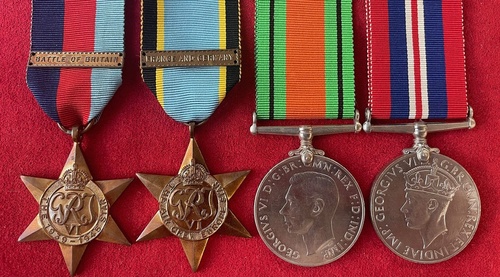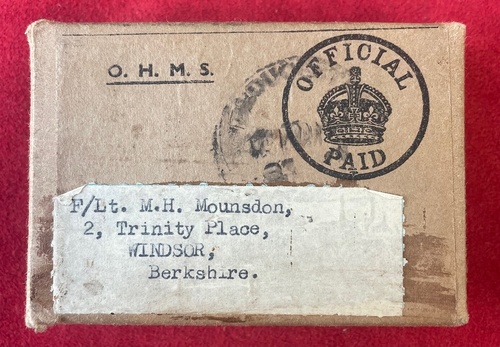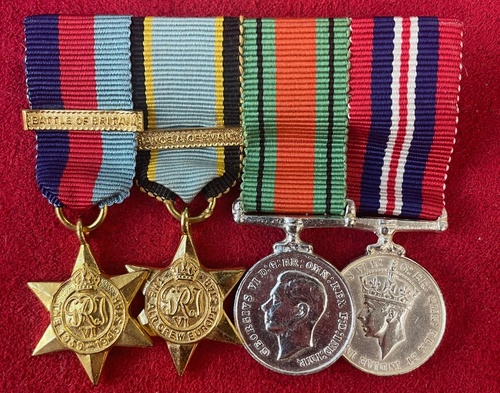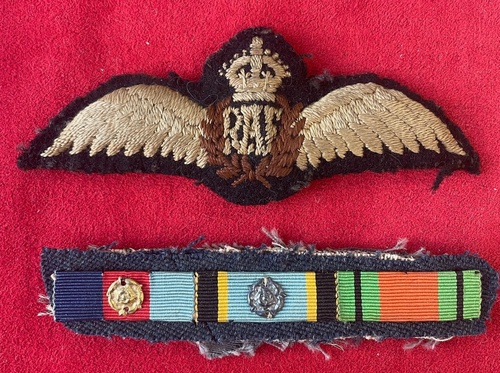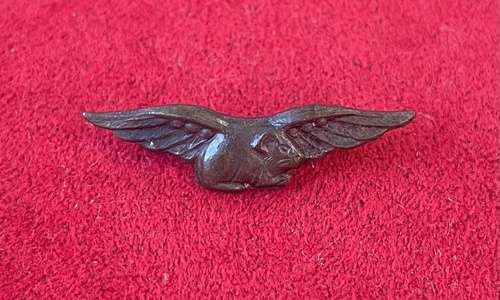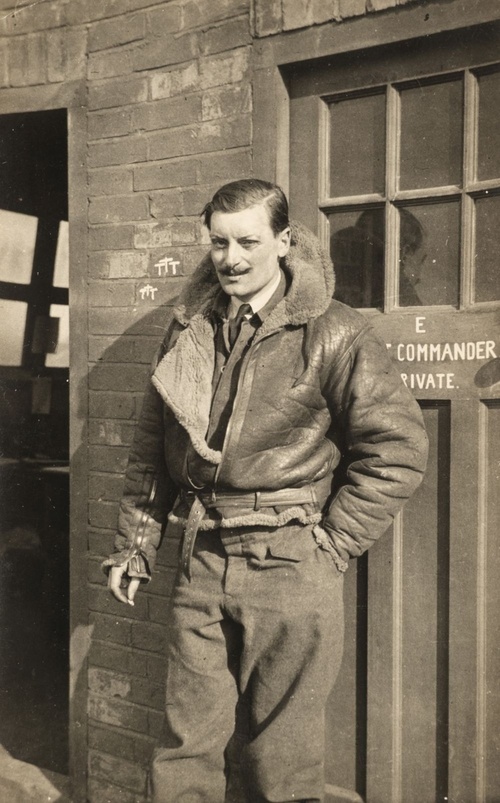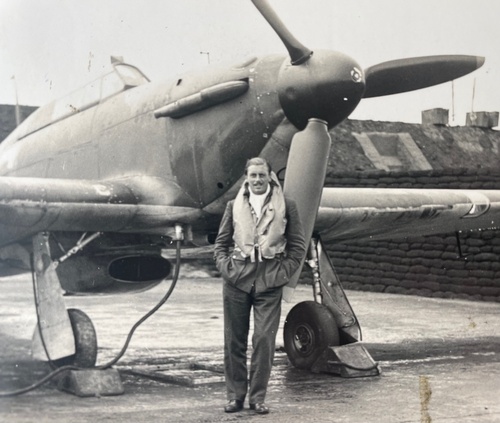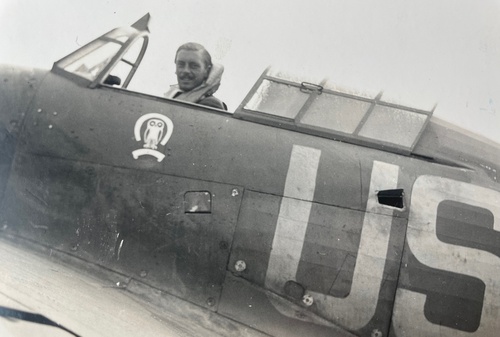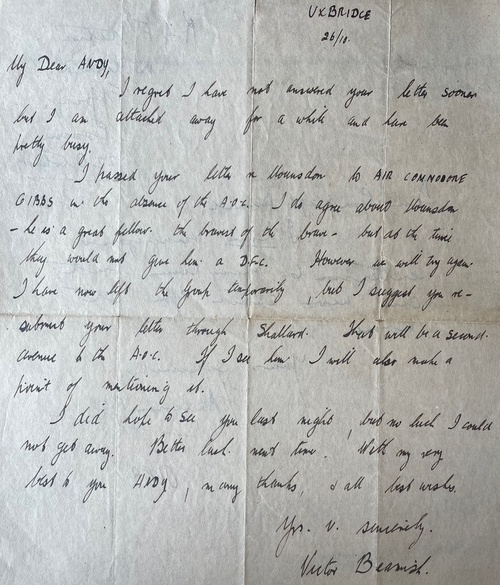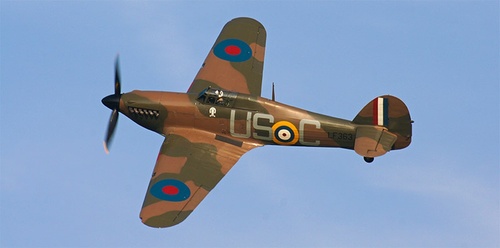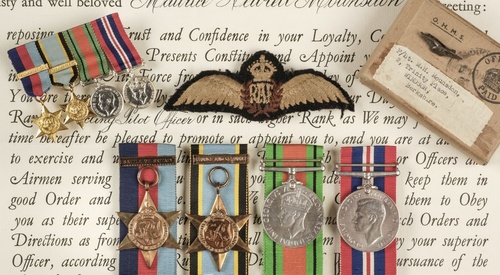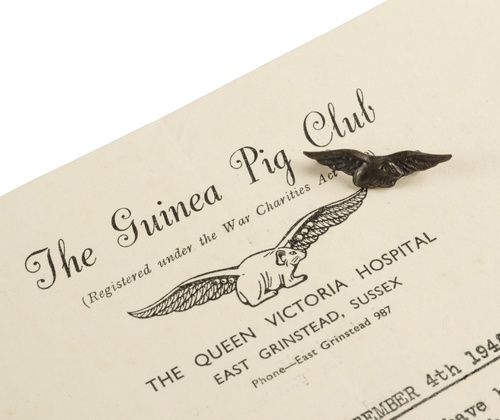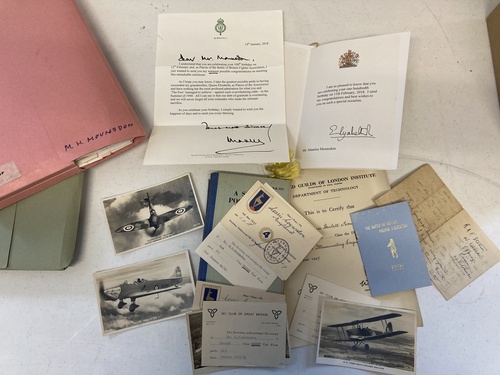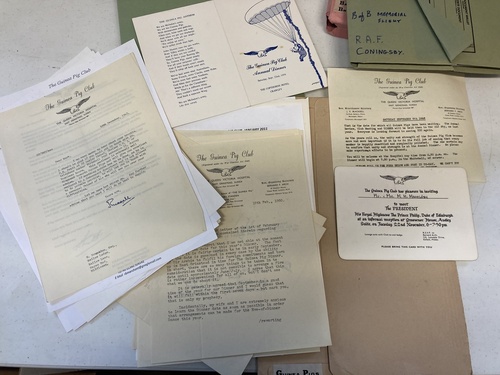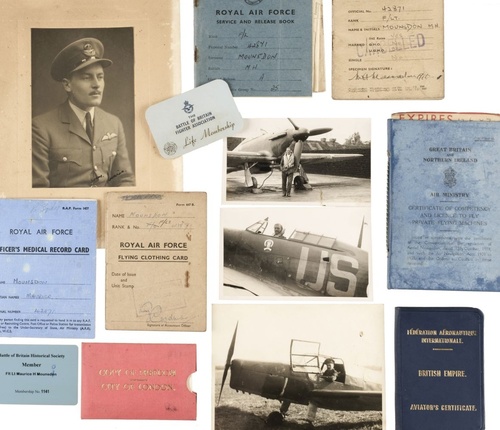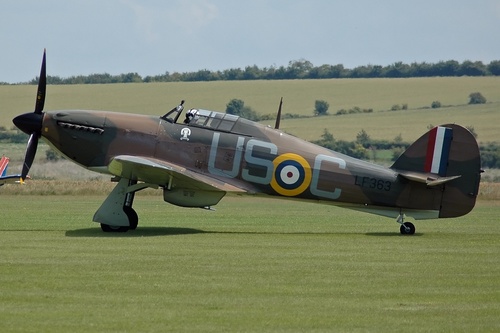Auction: 25001 - Orders, Decorations and Medals
Lot: 98
The well-documented and quite outstanding Battle of Britain Aces' group of four awarded to Flight Lieutenant M. H. Mounsdon, Royal Air Force, who flew with No. 56 (Punjab) Squadron - the Firebirds - he very much lived up to their sobriquet in claiming Ace status during the famed summer of 1940
Having torn up the skies of Southern England, Mounsdon was shot down by Me109's on 31 August 1940 and suffered dreadful burns to his face, hands and legs; that precipitated a protracted stay at the Queen Victoria Hospital, East Grinstead, going under the knife of Sir Archibald McIndoe on no less than five occasions, earning his membership to the Guinea Pig Club; he was one of the last handful of 'The Few' when he died in 2019
1939-45 Star, clasp, Battle of Britain; Air Crew Europe Star, clasp, France and Germany; Defence and War Medals 1939-45, in their postal box of issue, including Air Council forwarding note and with waxed envelopes, the box named to 'F/Lt. M. H. Mounsdon, 2, Trinity Place, Windsor, Berkshire', nearly extremely fine
Sold together with a remarkable - and most extensive - original archive of material comprising:
i)
His miniature dress medals, mounted as worn.
ii)
Two pairs of cloth RAF 'Wings', besides his riband bar cut from his tunic, with gilt rosette upon the 1939-45 Star riband, denoting 'Battle of Britain'.
iii)
Guinea Pig Club pin-back badge, as presented to Mounsdon after his stay in East Grinstead, together with documents and letters of this nature.
iv)
His Warrant as Temporary Acting Pilot Officer, 2 November 1939, Royal Air Force Service and Release Book (Form 2520C), besides Officer's Pay and Allowances Book, Officer's Medical Record Card and Flying Clothing Card.
v)
Royal Aero Club Aviator's Certificate No. 21217, dated 22 May 1946 and Air Ministry Private Pilot's Licence, July 1946-July 1947.
vi)
Copy of Freedom City of London, 29 September 1970, the certificate with red and gilt sleeve and Rules for the Conduct of Life booklet.
vii)
The Battle of Britain Fighter Association Life Membership card, Battle of Britain Historical Society card, Royal Over-Seas League Life Membership card, Technician Engineer card
viii)
The Battle of Britain, by H.M.S.O., presentation copy with illuminated dedication stating 'To Pilot Officer M. H. Mounsdon, a small Remembrance of a visit to High Easter 24th Sept 1987.
ix)
Battle of Britain World Premiere programme.
x)
Photograph album, with a series of personal wartime images with his family whilst on leave.
xi)
Two No. 56 Squadron wall plaques, both of some age, one with two pairs of 'Wings' affixed to the reverse.
xii)
Birthday Card on his 100th birthday from The Queen, besides letter, signed 'Charles', Prince of Wales, on the same day as Patron of the Battle of Britain Fighter Association.
xiii)
Various folders including relevant letters, newspaper cuttings, besides much correspondence and material. (Lot)
In the first instance, the cataloguer turns to The Telegraph to offer a suitable biography:
'Flight Lieutenant Maurice Mounsdon, who has died aged 101, was one of the last remaining Battle of Britain pilots, and with his death there are now only three surviving veterans of that decisive conflict.
On June 3 1940 Mounsdon joined No 56 Squadron to fly Hurricanes. Operating from North Weald in Essex, he shared in the destruction of a Dornier 17 bomber on July 3. Three weeks later he probably destroyed a Junkers 87 “Stuka”. As the battle intensified in mid-August he destroyed two Messerschmitt fighters and a probable third.
He was scrambled again early on the morning of August 31. At 15,000 ft his squadron attacked a large formation of enemy bombers over Colchester: he engaged one of the escorting fighters and registered some hits. As he pulled away a Messerschmitt Bf 109 opened fire on him from behind and shot down his Hurricane.
Mounsdon was wounded in the leg and bullets hit the gravity petrol tank behind the instrument panel, which exploded, blowing petrol into the cockpit, which instantly caught fire. “Up it went,” he recalled, “and I was sitting in a blowlamp.”
There was only one thing to do, and that was to bale out as fast as possible. “I undid the Sutton harness, put the aircraft in a roll to starboard, stood up and pushed myself over the side.” He landed in a field a mile outside the village of High Easter in Essex, with little left of his clothing, which had been burnt away.
Farmers came over with pitchforks in hand and at first he had some trouble convincing them he was not German. The local ARP warden came to his aid, however, and rushed him into the hospital at Black Notley near Braintree, where he spent the next 11 weeks.
Mounsdon had suffered severe burns to his arms and legs. Interviewed by the BBC in 2015, he described the initial sensation of his burns as “acute discomfort”, adding: “The pain comes later.” He spent much of the next two years in hospitals and became one of the early members of the association and support network known as the Guinea Pig Club, after numerous skin grafts and treatments by the pioneering plastic surgeon Archibald McIndoe at East Grinstead’s Queen Victoria Hospital.
It was while he was recovering that, in 1941, he married Mary Allen.
Mounsdon reflected on his involvement in the Battle of Britain in an interview with The Times last year: “The dogfights were pretty frightening. Everyone was firing at the same time. It was a matter of luck if you survived or not … But at the end of it all it was the happiest time of my life, though I lost a lot of good friends. ”Maurice Hewlett Mounsdon, the son of an electrical engineer who served with the London Regiment during the First World War, was born on February 11 1918 in Lichfield. He joined the RAF on a short-service commission in August 1939.
After his long period in hospital, Mounsdon became an instructor at a number of elementary flying schools, first near Cambridge and then at Booker in Buckinghamshire.
As the war ended he joined No 8303 Air Disarmament Wing in Germany based near Trier. The task was to disarm and disband the Luftwaffe, including the disposal of equipment and munitions in its allocated area.
Some of the German personnel were retained to work for the RAF in service units. The work of the wing included dismantling the air defence artillery and the numerous industrial locations carrying out manufacturing and repair work for the Luftwaffe.
Mounsdon was released from the RAF in February 1946 and worked as an engineer in areas around London. When he retired he moved to Menorca, where he spent the rest of his life. He was an expert model engineer, mostly building magnificent large-scale British steam locomotives.
At the time of his 100th birthday, the RAF’s Red Arrows were in Menorca and the nine Hawk jets put on a spectacular display as Mounsdon watched from a friend’s apartment, including creating a “100” in the sky with their coloured smoke. He later commented: “It was a real honour for me for the Red Arrows to come to Menorca and put on this display.”'
With the passing of Group Captain Hemingway on 25 March 2025, the final chapter closed on 'The Few'. Mounsdon was a shining light of their number and a wartime letter, which accompanies the Lot, from Group Captain Francis Victor Beamish, D.S.O. & Bar, D.F.C., A.F.C. gives more insight into the views of his comrades at the time:
'Uxbridge 26/10 [1941?]
My Dear Andy,
I regret I have not answered your letter sooner but I am attached away for a while and have been pretty busy.
I passed your letter on Mounsdon to Air Commodore Gibbs in the absence of the AOC. I do agree about Mounsdon - he is a great fellow. The bravest of the brave - but at the time they would not give him a D.F.C.. However we will try again...'
He was clearly a central figure in the 'Firebirds', being captured for the British Pathe film Fighter Station Scramble during the Battle of Britain. Despite not getting the decoration that he perhaps should have done, he earned Ace status before the fateful combat of 31 August 1940, which saw him spend so many months at East Grinstead. Under the careful watch - and knife - of Archibald McIndoe, he went through no less than five operations to repair the burn wounds to his face, hands and legs, becoming one of the first members of the Guinea Pig Club.
Having lived a very full life, he would regularly attend Battle of Britain re-unions and anniversary events. Mounsdon recalled being shot down for the BBC in 2015:
www.bbc.co.uk/news/av/uk-50715406
His old Hurricane Mk II LF363 remains in the Battle of Britain Memorial Flight, painted as 'US-C' in the colours of No. 56 Squadron.
Subject to 20% VAT on Buyer’s Premium. For more information please view Terms and Conditions for Buyers.
Estimate
£18,000 to £22,000
Starting price
£16000

